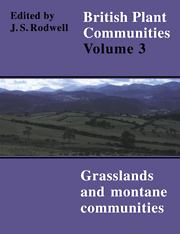Book contents
- Frontmatter
- Contents
- List of Figures
- Preface and Acknowledgements
- Preamble
- Mesotrophic Grasslands
- Community Descriptions
- Calcicolous Grasslands
- Community Descriptions
- Calcifugous Grasslands and Montane Communities
- Community Descriptions
- Index of Synonyms to Grasslands and Montane Communities
- Index of Species in Grasslands and Montane Communities
- Bibliography
U10 - Carex Bigelowii-Racomitrium Lanuginosum Moss-Heath
Published online by Cambridge University Press: 04 July 2020
- Frontmatter
- Contents
- List of Figures
- Preface and Acknowledgements
- Preamble
- Mesotrophic Grasslands
- Community Descriptions
- Calcicolous Grasslands
- Community Descriptions
- Calcifugous Grasslands and Montane Communities
- Community Descriptions
- Index of Synonyms to Grasslands and Montane Communities
- Index of Species in Grasslands and Montane Communities
- Bibliography
Summary
Synonymy
Rhacomitrium heath Smith 1900b, Smith 1911 b, Price-Evans 1932, Tansley 1939, Ratcliffe 1959a, Edgell 1969; Moss-lichen associes Smith 1911b, Watson 1925, Price-Evans 1932, Tansley 1939, p.p.; Rhacomitrium-Carex bigelowii nodum Poore 1955c, Poore & McVean 1957, Huntley 1979; Dicranum fuscescens-Carex bigelowii sociation Poore 1955c; Cariceto-Rhacomitretum lanuginosi McVean & Ratcliffe 1962, Birks 1973; Polygoneto-Rhacomitretum lanuginosi McVean & Ratcliffe 1962; Juncus trifidus-Festuca ovina nodum McVean & Ratcliffe 1962; Festuca ovina-Luzula spicata nodum Birks 1973; Agrostis montana-Rhacomitrium lanuginosum community Birse & Robertson 1976; Rhacomitrium lanuginosum-Dicranum fuscescens nodum Huntley 1979; Festuco-Rhacomitretum lanuginosi Birse 1980; Carex bigelowii-Festuca vivipara Association (Birse & Robertson 1976) Birse 1980 p.p.
Constant species
Carex bigelowii, Deschampsia flexuosa, Festuca ovinal vivipara, Vaccinium myrtillus, Racomitrium lanuginosum, Cladonia uncialis.
Rare species
Artemisia norvegica, Diapensia lapponica, Koenigia islandica, Loiseleuria procumbens, Luzula arcuata, Minuartia sedoides, Sibbaldia procumbens, Aulacomnium turgidum, Hypnum hamulosum, Kiaeria starkei, Nephroma arctica.
Physiognomy
The Carex bigelowii-Racomitrium lanuginosum community takes in both continuous carpets of mossy heath and much more open vegetation in which Racomitrium lanuginosum remains an important distinguishing feature. In the closed swards included here, this moss is often truly dominant, forming an extensive, sometimes total, cover of densely-packed shoots, frequently curled over all in one direction by relentless winds, but growing together as a vigorous mat up to 5 cm or so thick, which can be peeled off the rocky substrate beneath. From this kind of vegetation, which can stretch for many hectares over broad plateaus, there is a complete gradation through broken rocky ground with more patchy carpets, to almost barren stone-littered surfaces on which small clumps of R. lanuginosum are virtually the only cover.
Some other mosses play a more infrequent, but locally prominent, role in the community, though this variation is not of itself sufficient to characterise different kinds of Carex-Racomitrium heath (cf. Poore 1955c, Huntley 1979). Most obvious among these is Dicranum fuscescens which is only occasional throughout but sometimes patchily abundant within masses of R. lanuginosum, often where there are slight depressions, perhaps just a few centimetres deep, which catch and hold a little snow in the winter. Some of these spots are clearly transitional to late snow-beds, but often the effect is just to produce a mosaic within the moss carpet of what is otherwise fairly uniform vegetation.
- Type
- Chapter
- Information
- British Plant Communities , pp. 403 - 416Publisher: Cambridge University PressPrint publication year: 1992

